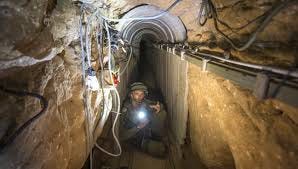“I have destroyed Khan Younis, over and underground. It is rubble.” The words of one IDF commander sum up the scale of the devastation in Gaza, with the vital word of that sentence being “underground”. Every bit of violence and damage to Gaza we see during this war can be explained by the tunnels.
The Gaza tunnel network, constructed and deployed by Hamas under the leadership of Yahya Sinwar, stood as one of the most formidable strategic weapons in modern asymmetrical warfare. They infest every area of Gaza and most civilian buildings. To destroy the tunnels, the IDF have had to destroy what sits on top of them: homes, hospitals, schools, mosques.
Until the current war, the concept of the tunnels as a weapon has escaped Western and Israeli planners. Coupled with the potential implications of a similar network in Southern Lebanon constructed by Hezbollah, the Israeli experience of Gaza’s tunnels underscores the complex and evolving nature of modern asymmetric urban conflict. Israeli strategists failed to fully appreciate that the tunnels were not simply a defensive asset or a logistics hub: they were a weapon.
The tunnel network in Gaza, often referred to as the “Gaza Metro”, was a series of underground passages 400 miles in length before the IDF began its destruction. To give an idea of scale, the whole of Gaza is only 225 square miles. The “Gaza Metro” was denser than the New York subway and longer in distance than the London Underground. It was a highly sophisticated and integrated military infrastructure and economic driver through smuggling revenue. This system allowed Hamas to operate in a three-dimensional battlespace, where the ground and air were contested by Israel, but the subterranean environment was retained under Hamas's control.
Over nearly two decades, this network grew into an extensive labyrinth under every inch of Gaza, including tunnels for smuggling between Gaza and Egypt, storage, living areas, movement of personnel, and manufacture and launch sites for rockets and other weapons. A Hamas commander could walk from his office to the shop, and back to his house, without ever seeing daylight. Accommodation areas have astroturf in place of grass. Bathrooms are tiled and have working sewerage pipes. Tunnels have been found with built-in cages for hostages. DNA evidence of the hostages’ presence has been discovered. Also found were stocks of vitamins: Hamas fighters are prepared for many months without Vitamin D from sunlight.




